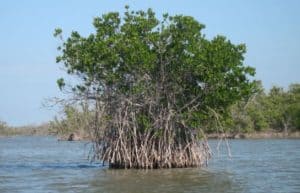Ocean ecosystem is one of the examples of this Earth’s great diversity of life and habitats. This great variety is influenced by geographical, climate, or the physical factors of the ocean itself. Ocean has an average depth of 3,800 meters and that volume is the home to unique organisms. Throughout this article, we can know more about what are the things that build an ocean ecosystem. Furthermore, we will understand about a different unique ecosystem that is affected by the depth of the ocean and how those unique organisms interact with each other through ocean ecosystem food chain. (See also: Ocean Environment )
Ocean Ecosystem
Pelagic zone, or as we know as the ocean ecosystem, is the largest collective ecosystem on the planet. It accounts for around 71% of this planet’s surface and almost of it is water which interestingly contains enough water to fill a cube with over 1000 kilometers in length. The realm of ocean has the greatest depth and volume of any living zone on Earth. The region of Deep Ocean Ecosystems includes the region above continental shelf (neritic province) and the region beyond (oceanic province). The diversity of the habitats are caused by the gradations of light, temperature, water chemistry, nutrient content and also pressure.
Ocean ecosystem includes open oceans and shoreline habitats, plants and animals. Though scientists have spent decades to discover the complete marine life forms, there are still many that are yet to be discovered. Most of those that are consisted in the ecosystem live in the euphotic zone, although we can also find life from the top to the bottom of the oceans. Euphotic zone is a zone or region where the photosynthesis is available due to the enough sunlight coming to that certain depth of the water. (See also: Ocean Natural Resources)
Besides that, ocean ecosystem depends and needs nutrients, which come from the rising of the cold currents that are rich in nutrients to the ocean surface from the bottom of the deep ocean and from the neritic, areas where water washes off land. The quantity of the nutrients also determine the abundance of the organisms, the more nutrients found in that ocean region, the more organisms are there also. (See also: Waves in Ocean)
One of the examples of the most productive (rich in nutrients) body of water is the west coast of South America. Here, the large population of phytoplankton is supported by the abundance of the nutrients. As primary sources increase, the fish population increases, the opposite also applies, such as the aftermath of the El Nino event in Peru when the fish population decreases significantly or if worsen by the overfishing, may collapse.
See also:
Division
Ocean ecosystem are made up of a community of living and non-living things, it consists of shoreline habitats, plants and animals. They support the life of one another and dependent towards one another. These are the major parts of ocean ecosystem.
1. Shoreline Habitats
Shoreline habitats are consisted of mud flats, coral reefs, barrier island, estuaries, flat marshes and mangrove forests. Coral reefs and mangrove forests are two types of specialized Deep Ocean Ecosystems. The reason behind this is because of their high productivity, they are the living zone for a unique and diverse plants and animals.
a. Coral Reefs
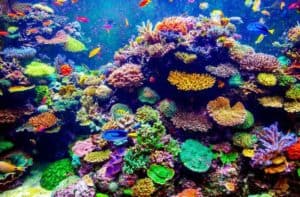 Inside the ocean ecosystem, coral reefs ecosystems are considered the most diverse on the planet. Coral reefs are the most dominant ecosystem among any shallow water Deep Ocean Ecosystems.
Inside the ocean ecosystem, coral reefs ecosystems are considered the most diverse on the planet. Coral reefs are the most dominant ecosystem among any shallow water Deep Ocean Ecosystems.
It comprises of a various number of species and it serves as a feeding, breeding, nursery and spawning ground for a large number of organisms.
See also:
b. Mangrove Forests
Mangrove forests are other specialized Deep Ocean Ecosystems, for the same reason as their high productivity and diversity. Mangrove roots are submerged in a condition that is unique and may not applicable to any other trees; they are submerged in hot, muddy and shallow salt water.
Many kinds of sea birds, insects and reptiles depend and stay in mangrove ecosystem while some of the shallow water animals, such as crustaceans and fishes, all take residence in the mudflats that are connected to the mangrove shoreline.
2. Ocean Plants
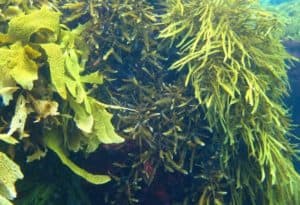 There are several plants in Deep Ocean Ecosystems, which include seaweed, kelp, algae, sea grasses and plankton. Planktons are tiny organisms that move with water currents and dominate the pelagic life.
There are several plants in Deep Ocean Ecosystems, which include seaweed, kelp, algae, sea grasses and plankton. Planktons are tiny organisms that move with water currents and dominate the pelagic life.
The pelagic zone in which those planktons exist is called epipelagic zone, a zone in which there is an adequate amount of sunlight and extends to a depth of 200 meters below the surface.
The sunlight is the power of the photosynthesis of these microscopic plants. (See also: Effects of Ocean Currents)
The photosynthesis result from the phytoplankton has become the primary food source for all ocean life, directly and indirectly. Phytoplankton has a large effect on the Earth’s atmosphere because as plants in general, phytoplankton uses CO2 (Carbon Dioxide) and releases O2 (Oxygen). Carbon dioxide is highly soluble in ocean water and ocean itself is a carbon dioxide sink.
To control the atmospheric levels of carbon dioxide, a manipulation of oceanic chemistry has been proposed and this in turn may help to reduce greenhouse warming. If the population of phytoplankton were increased on a large scale, they may use more carbon dioxide. But when they died, some would fall to the sea floor and taking with them the carbon they harvested from the atmospheric CO2. (see also: Surface of Tension Liquids)
The growth of phytoplankton in the large regions of the ocean is limited by lack of the trace of element iron. The researchers conduct an experiment by fertilizing small patches of sea water with a minute amount of dissolved iron. The iron then triggers the growth of phytoplankton in which the rate is doubled and the biomass increases by approximately thirty times and its nitrate uptake increases by fourteen times.
Besides phytoplankton and its great role, there are other plants in ocean ecosystem such as seaweeds, marine algae, sea grasses and mangroves which have been mentioned before.
3. Ocean Animals
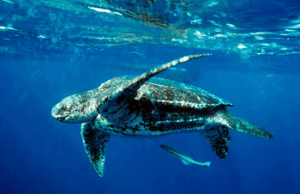 Ocean is the largest animal habitat on Earth and it is so huge that even years and years spent on discovering the complete animal habitat inside the ocean is still not enough. Animal life can be found at all depths which will be discussed in later section of this article.
Ocean is the largest animal habitat on Earth and it is so huge that even years and years spent on discovering the complete animal habitat inside the ocean is still not enough. Animal life can be found at all depths which will be discussed in later section of this article.
Other than ocean vertebrates such as mammals, fishes and birds, there are many more different type of animals consisted in the Deep Ocean Ecosystems, such as one-celled minuscule protozoa, anemones, zooplankton, invertebrates, such as mollusks and crustaceans, sea stars, cetaceans, sea lions, seals and many other.
Some of the most popular kinds of sea mammals are whales, dolphins, sharks and seals. Other kinds of animals are star fish, walrus, eel, crabs, jelly fish, fresh and salt water fishes. Most of the small fishes are herbivores and larger fishes are carnivores. There is a certain rule in ocean ecosystem: larger fish will eat smaller fish. This food chain will be discussed in the next section. (see also: Climate of the Ocean)
In general, the fishes that are consisted inside the marine biome is differentiated by 5 kind of adaptations:
- Sleek Body: The sleek body is designed as such to cut down the friction when they swim through the water.
- Gills: This part allows them to breath underwater.
- Eyes: Fishes have eyes on the side of their heads so they can see enemies coming.
- Fins: To help them swim faster. (See also: Global Warming in Ocean)
- Color-coded Skin: As a defense, so it is easier for them to hide from their predators.
Jelly Fish
One of the most interesting “fish” but which is actually not a fish is jellyfish or some call it jellies. Surprisingly, even before dinosaurs exist on Earth, jellyfish have drifted along on ocean currents. Jellyfishes are categorized in invertebrates and they are abundant in deep water, along coastlines and in warm and cold ocean water.
Their way of defense is to paralyze their prey before feeding on them. They use their tentacles that are equipped with tiny stinging cells to stun their enemies. They eat those preys through an opening (mouth) in their body, this opening is also used to discard waste. They feed on shrimps, fishes, crabs and tiny plants. Jellyfishes have variant color, some are clear while some are vibrant in colors, such as yellow, pink, purple, blue and often luminescent.
4. Ocean Layers
Ocean Layers also commonly called zone. The largest ecosystem on Earth is contained in the ocean. The ocean itself is divided into two zones, demersal zone and pelagic zone. Demersal zone is the zone that extend from the deep ocean to the coast while the rest of other region in the sea in pelagic zone. Most of ocean ecosystem is found in the pelagic zone. Pelagic zone is divided in four categories depending on its depth and each contains an unique array of organisms.
Epipelagic
This is the zone in which sunlight penetrates through and it powers phytoplankton to undergo photosynthesis. Phytoplankton also blooms due to the nutrients that are driven by the upwelling stream. The bloom of phytoplankton will then feed herbivores such as zooplankton, invertebrates and vertebrates herbivores which then feed small fishes and small fishes feed larger fishes. This food map will be explained in later section.
Mesopelagic
In this depth, a very little light is able to penetrate through and because of this reason, plants cannot conduct photosynthesis. Fishes in this zone have certain characteristics, such as large in size, sharp teeth, expandable jaws and stomachs. This physiology supports them to feed on organisms that are larger than themselves. Though the light is scarce there, some of the organisms here may produce their own light through their bioluminescent organs, such as lantern fish, ctenophores and firefly squids.
Bathypelagic
No light penetrates this zone. The organisms here have the same characteristics with those in the mesopelagic zone and some even have no eyes. The primary source of their food is from the plants and animals that sink from higher zones. There are still fishes that able to survive in this depth through their evolution of strong gills so that they are able to extract oxygen from water under tremendous pressure. Those fishes are becoming the source of food for sperm whale and squid that sometimes dive into this zone.
Abyssopelagic
This zone becomes the habitat for jellies, fishes, crustaceans and mollusks that are adapted to survive in highly pressurized condition and feed on decomposing organisms (detritus). Some are invisible because of the black and red color; however some are bioluminescent which make them visible. Those living in the abyssopelagic zone develop certain function that helps them to survive, for example vampire squid. This squid is able to turn itself inside out and uses its spike-like tentacles to capture food and scare predator.
5. Food Chains
Alike the ecosystem on the land, ocean ecosystem is also consisted of a unique type of food chain. Food chain is the way in which organisms get food and how energy and nutrients are passed from organism to another organism in a given environment. The moving of this energy happens when one creature eats another creature. Generally, food chain begins with plant and end with animal. Below is the food web for ocean ecosystem and the way in which those organisms interact and depend on each other for survival.
- Plants
Photosynthesizing organism is the producer in most of food chain. Not only in land, plants also play a great role in ocean ecosystem food chain and it works similarly to the plants on the land. Through the photosynthesis, they convert carbon dioxide and nutrients into organic carbon that is need for the rest of ocean’s organism survival. Other than that, oceanic photo-autotrophs are the primary producer of the oxygen that we breathe on Earth.
Due to the organic carbon that is being released by the plants, plants are placed on the first level of ocean ecosystem food chain. Some of the plants in this first level of food chain are phytoplankton, seaweed, sea grass, and many other plants. Those plants are then consumed by herbivores, animals that get its energy from eating only plants and leads to the second level of ocean ecosystem food chain.
- Herbivores
This level is consisted on animals that feed on ocean’s plant life and sometimes they are called primary consumers. Herbivores that is included in this level range from the microscopic size such as zooplankton, which include jellyfish and the early stages of some fish, mollusks and barnacles to the large size of herbivores such as certain type of fishes such as surgeonfish, parrotfish, green turtles and manatees.
Zooplankton feeds on the ocean’s phytoplankton and those larger in size, invertebrates (sea urchins) and vertebrates eat on seaweed and sea grasses. Level one is being devoured by the level two of the food chain, while level two will then be the source of food for level three, carnivores.
- Carnivores
Carnivores are those animals that derive its energy from the consumption of animal tissue and in the level three of ocean ecosystem food chain, carnivores are the main resident. Carnivores are large and diverse and their sizes also range from small to large. Small carnivores include fishes such as sardines, herring and menhaden. Large carnivores include octopuses that feed on herbivores such as crabs and lobsters and.
Besides octopuses, there are many fishes that are also categorized in carnivores section. Those fishes feed on small invertebrates that live near shore. However, although they are maybe predators for herbivores, but the rule in ocean leads to one simple fact: big fishes eat smaller fishes. These big fishes are the top level of ocean’s ecosystem food chain.
- Top Predators
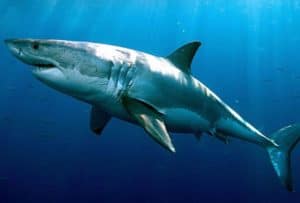 Top predators get their nourishment from the smaller carnivores and similar to the other groups in the food chain, this group is also a diverse group that may or may not have predators other than human.
Top predators get their nourishment from the smaller carnivores and similar to the other groups in the food chain, this group is also a diverse group that may or may not have predators other than human.
Large predators may include finned (such as dolphins, tuna, sharks), feathered (such as penguins, pelicans) and flippered (such as walruses, seals).
What differentiates them from the level three is that they are faster, larger and better at catching prey.
Their reproduction is slower and long lived, because of its slow reproduction, when this top level of food chain is being hunted by humans, their numbers are depleted and the loss may send shock waves for the entire food chain.
Besides this leveled food chain, there is other alternative food chain inside ocean ecosystem and it exists at the deep sea level in which sunlight cannot pass through. They are independent of sun energy and their ecosystems derive from the chemical energy that enters the ocean. This dark zone is believed to have a great range of marine life.
See also: Endangered Sea Turtles List – Types of Sea Urchins
As we have read through this article that Deep Ocean Ecosystems is so mesmerizing and mysterious at the same time. It ranges from living to non-living things, from tiny to monstrous, from vertebrates to invertebrates and ocean ecosystem is so voluminous that for every species that we have known of, which had reached 250,000 numbers of species, and there are still another three that are yet to be discovered. As human, we are responsible to take care of the Earth’s ocean so that the ecosystem may live longer and provide us knowledge that may create a better life for us.
Other Ocean Facts
